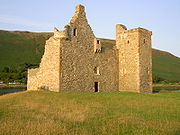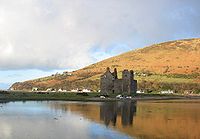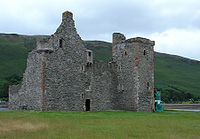
Lochranza Castle
Encyclopedia


Tower house
A tower house is a particular type of stone structure, built for defensive purposes as well as habitation.-History:Tower houses began to appear in the Middle Ages, especially in mountain or limited access areas, in order to command and defend strategic points with reduced forces...
situated on a promontory
Headlands and bays
Headlands and bays are two related features of the coastal environment.- Geology and geography :Headlands and bays are often found on the same coastline. A bay is surrounded by land on three sides, whereas a headland is surrounded by water on three sides. Headlands are characterized by high,...
in the middle of Lochranza
Lochranza
Lochranza is a village located on the Isle of Arran in the Firth of Clyde, Scotland. The population, somewhat in decline, is around 200 people....
, on the North of the Isle of Arran
Isle of Arran
Arran or the Isle of Arran is the largest island in the Firth of Clyde, Scotland, and with an area of is the seventh largest Scottish island. It is in the unitary council area of North Ayrshire and the 2001 census had a resident population of 5,058...
in Scotland
Scotland
Scotland is a country that is part of the United Kingdom. Occupying the northern third of the island of Great Britain, it shares a border with England to the south and is bounded by the North Sea to the east, the Atlantic Ocean to the north and west, and the North Channel and Irish Sea to the...
. Most of the present castle today was built in the sixteenth century.
The original building dates to the thirteenth century when it was owned by the MacSweens
Clan Sweeney
Clan Sweeney is an Irish clan of Scottish origin. The clan did not permanently settle in Ireland before the beginning of the 14th century, when they became Gallowglass soldiers for the O'Donnell dynasty of Tyrconnell...
. In 1262, King Alexander III
Alexander III of Scotland
Alexander III was King of Scots from 1249 to his death.-Life:...
granted the castle and its lands to Walter Stewart, the Earl of Menteith
Walter Bailloch
Walter Bailloch or Walter Bailloch Stewart , was third son of Walter Stewart, 3rd High Steward of Scotland, and Earl of Menteith jure uxoris. His wife was Mary I, Countess of Menteith...
. It is believed that Robert the Bruce
Robert I of Scotland
Robert I , popularly known as Robert the Bruce , was King of Scots from March 25, 1306, until his death in 1329.His paternal ancestors were of Scoto-Norman heritage , and...
landed at Lochranza in 1306 on his return from Ireland
Ireland
Ireland is an island to the northwest of continental Europe. It is the third-largest island in Europe and the twentieth-largest island on Earth...
to claim the Scottish throne. By 1371, the castle has become the property of Robert II
Robert II of Scotland
Robert II became King of Scots in 1371 as the first monarch of the House of Stewart. He was the son of Walter Stewart, hereditary High Steward of Scotland and of Marjorie Bruce, daughter of Robert I and of his first wife Isabella of Mar...
. It is thought that at this time it was used as a royal hunting lodge.
The castle has seen many varied uses over time. During the 1490s, James IV
James IV of Scotland
James IV was King of Scots from 11 June 1488 to his death. He is generally regarded as the most successful of the Stewart monarchs of Scotland, but his reign ended with the disastrous defeat at the Battle of Flodden Field, where he became the last monarch from not only Scotland, but also from all...
used the castle in his campaign against the Lord of the Isles
Lord of the Isles
The designation Lord of the Isles is today a title of Scottish nobility with historical roots that go back beyond the Kingdom of Scotland. It emerged from a series of hybrid Viking/Gaelic rulers of the west coast and islands of Scotland in the Middle Ages, who wielded sea-power with fleets of...
and his Clan MacDonald
Clan Donald
Clan Donald is one of the largest Scottish clans. There are numerous branches to the clan. Several of these have chiefs recognised by the Lord Lyon King of Arms; these are: Clan Macdonald of Sleat, Clan Macdonald of Clanranald, Clan MacDonell of Glengarry, Clan MacDonald of Keppoch, and Clan...
. In 1614 it was occupied by James VI
James I of England
James VI and I was King of Scots as James VI from 24 July 1567 and King of England and Ireland as James I from the union of the English and Scottish crowns on 24 March 1603...
and in the 1650s it was used by Cromwell
Oliver Cromwell
Oliver Cromwell was an English military and political leader who overthrew the English monarchy and temporarily turned England into a republican Commonwealth, and served as Lord Protector of England, Scotland, and Ireland....
.
By 1705, Lochranza Castle had become the property of the Hamilton family, when it was purchased by the Duchess of Hamilton. The Hamilton family had owned other estates on the Isle of Arran
Isle of Arran
Arran or the Isle of Arran is the largest island in the Firth of Clyde, Scotland, and with an area of is the seventh largest Scottish island. It is in the unitary council area of North Ayrshire and the 2001 census had a resident population of 5,058...
. During the eighteenth century, the castle fell into disuse and disrepair and was abandoned. The castle is now in the care of Historic Scotland
Historic Scotland
Historic Scotland is an executive agency of the Scottish Government, responsible for historic monuments in Scotland.-Role:As its website states:...
.

The Adventures of Tintin
The Adventures of Tintin is a series of classic comic books created by Belgian artist , who wrote under the pen name of Hergé...
adventure The Black Island
The Black Island
The Black Island is the seventh of The Adventures of Tintin, a series of classic comic-strip albums, written and illustrated by Belgian writer and illustrator Hergé, featuring young reporter Tintin as the hero. It was first published in the newspaper supplement Le Petit Vingtième in the late 1930s...
, for the English translation in the 1960s
when the drawings were modernised. Bob de Moor, Hergé's chief post-war assistant
toured Britain following Tintin's exact footsteps, using various locations to produce a new series of background drawings. The castle appeared in "Dom Joly and the Black Island" on Channel 4
Channel 4
Channel 4 is a British public-service television broadcaster which began working on 2 November 1982. Although largely commercially self-funded, it is ultimately publicly owned; originally a subsidiary of the Independent Broadcasting Authority , the station is now owned and operated by the Channel...
TV on 19th March 2010, however it was portrayed as being Kisimul Castle
Kisimul Castle
Kisimul Castle is a small medieval castle located in the centre of Castlebay on Barra, an island of the Outer Hebrides, Scotland....
located on an island in Castlebay
Castlebay
Castlebay is the main village and a community council area on the island of Barra in the Outer Hebrides of Scotland. It is located on the south coast of the island, and overlooks a bay in the Atlantic Ocean dominated by Kisimul Castle, as well as nearby islands such as Vatersay.- Church :The...
harbour on the Isle of Barra in the Outer Hebrides
Outer Hebrides
The Outer Hebrides also known as the Western Isles and the Long Island, is an island chain off the west coast of Scotland. The islands are geographically contiguous with Comhairle nan Eilean Siar, one of the 32 unitary council areas of Scotland...
, after much was made of him reaching Barra and standing in Castlebay looking at Kisimul Castle. The next shots show Dom attempting to reach Lochranza Castle by boat with no mention of him no longer being on Barra.

